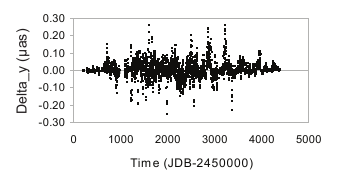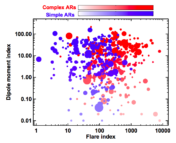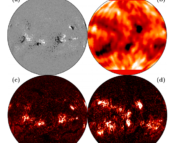Title: Why every observatory needs a disco ball
Authors: Robert J. Cumming, Alexander G.M. Pietrow, Livia Pietrow, Maria Cavallius, Dominique Petit dit de la Roche, Casper Pietrow, Ilane Schroetter, Moa Skan
First Author’s Institution: Onsala Space Observatory, Chalmers University of Technology, Onsala, Sweden
Status: Submitted to Physics Education / Available on arXiv
Tomorrow (Oct 14) an annular solar eclipse will cross parts of North, Central, and South America. Make sure you take proper precautions before viewing!
Are you looking for an affordable and accessible method to observe the Sun (perhaps while also adding to the general intrigue of your observatory)? The authors of today’s paper have a solution for both: disco balls! Read on to find out why you should get a disco ball for your observatory.
Don’t look directly at the Sun!
Proper precautions must be taken to observe the Sun. Sunlight is so intense that it can burn your eyes, possibly causing permanent damage and even blindness. One should not look at the Sun directly without the proper equipment, such as eclipse glasses or solar filters properly applied to binoculars or telescopes. Another convenient and affordable option are indirect methods for viewing a projection of the Sun, rather than looking directly at the source itself. One popular option is a pinhole camera, which can be constructed by punching a small hole in a piece of cardboard and allowing sunlight to filter through onto a screen (such as another blank piece of cardboard). Or you can use an already perforated material, such as a colander or cracker with docking holes. The projection– a shadow– is an inverted image of the Sun.

The reflective equivalent to the pinhole camera is the pinhead mirror. Here the tiny “pinhole”-sized aperture is traded for a tiny “pinhead”-sized mirror (see Figure 1). Light from the source is reflected by the mirror, creating a smaller and less-intense projection of the image. Disco balls, also known as mirror balls, are collections of many pinhead mirrors. They are readily available, and relatively affordable, running the gamut from earrings and holiday ornaments to high-end versions. These all have the potential to be used for solar observing. The authors also point out that if anyone gets too close to the mirrors– where the reflection is more concentrated and may pose a danger to their eyes– they would block out the reflection, thereby alerting the activity demonstrator.
The practicality of disco balls
First, the authors had to test whether disco ball mirror segments provide useful images of the Sun. They found that for the typical range of disco ball mirror segments (estimated at 0.4 to 1 cm), the optimal focal length is on the order of tens of meters. However, perfect focus isn’t necessary to discern the shape and even some details of the Sun. The author’s found that recognizable solar disks could be produced at two meters onwards, and discerned even further details (such as sunspots) at less than ten meters. They also found that a typical pinhead mirror should be able to produce an recognizable image of the Sun of at least five centimeters in diameter in most environments (image contrast depends on the ambient lighting).
A disco ball has many pinhead mirrors, producing many projections over a room or courtyard (Figure 2). This has several advantages. For one, a disco ball doesn’t need to be pointed or readjusted since different mirror segments will be illuminated as the position of the Sun changes in the sky. The spread of images also improves accessibility for larger or socially distanced groups, and may prove especially useful for classes of students by providing each individual with their own projection to study.

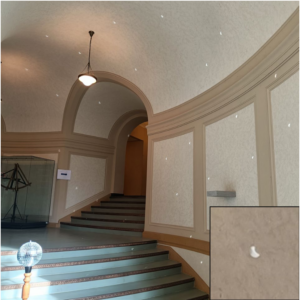
What can be observed?
The authors tested a variety of observations with a disco ball to assess its use as an educational tool. Figure 3 shows a test observation during a partial solar eclipse. The crescent-shaped image is the Sun partially blocked by the Moon, marking a successful observation of the eclipse.
The authors also had success observing sunspots (Figure 4), although they note these tests were performed during a period of moderate to strong solar activity, and that only the largest sunspots were visible. They suggest that large sunspots (with a size of at least 1-2 arcminutes) can regularly be observed with a disco ball projector during about half of each solar cycle. They also have confidence that the next transit of Venus (in 2117) will be observable with a disco ball. However, transits of Mercury are not likely observable due to the planet’s small angular size.
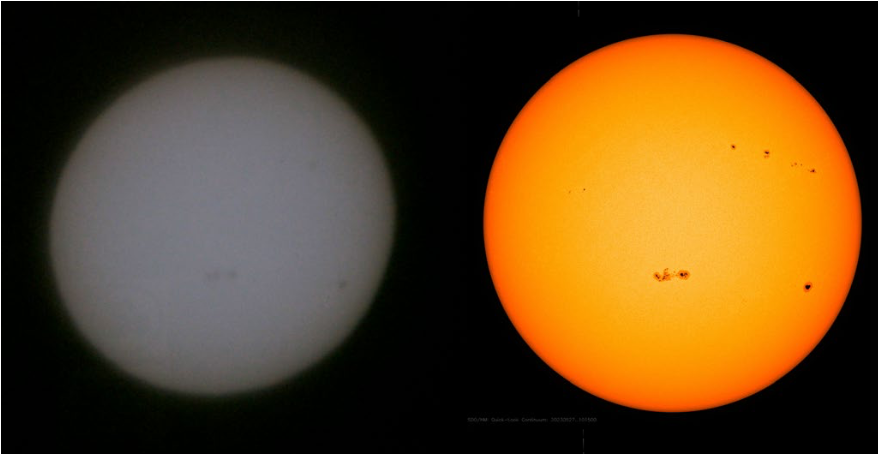
Astronomical sources other than the Sun can also be projected with a disco ball, but these observations are more difficult since these sources are typically much less bright. The authors successfully observed a full moon, noting that maximizing contrast by projecting the Moon’s image onto a dark surface is key.

A disco ball can also be used as a tool for lessons in optics. For example, projecting images at different distances allows for study of the difference between the pupil and focal planes, and geometric measurements can be used to calculate the diameter and brightness of the projected image. Imperfections in mirrors can also produce interesting effects, such as ghosts– secondary images that appear on either side of the primary image (see Figure 5). Comparing the brightness of the primary image and first and second ghosts allows calculation of the reflectivity of the mirror.
The authors also offer a list of suggestions for other experiments that could be conducted using the multiple images produced by a disco ball’s many pinhead mirrors. These include calculating the speed at which the Earth rotates around its axis (by measuring the movement of the projected images over time), measuring the change in intensity over time during an eclipse (by photographing the projected spots), determining the ellipticity of Earth’s orbit (by comparing seasonal changes in the solar disk size), and measuring solar limb darkening.
The case for disco balls
To recap: disco balls are readily available and relatively affordable, require minimal preparation to use, and are accessible for larger or socially distanced groups. They offer a safe and effective way to observe the Sun and conduct a range of solar and optical experiments. As an added bonus, their non-scientific associations make them interesting and unexpected tools for demonstrating physics to students and the general public. If you don’t have one already, get one for your observatory today!
Astrobite edited by Ivey Davis
Featured image credit

